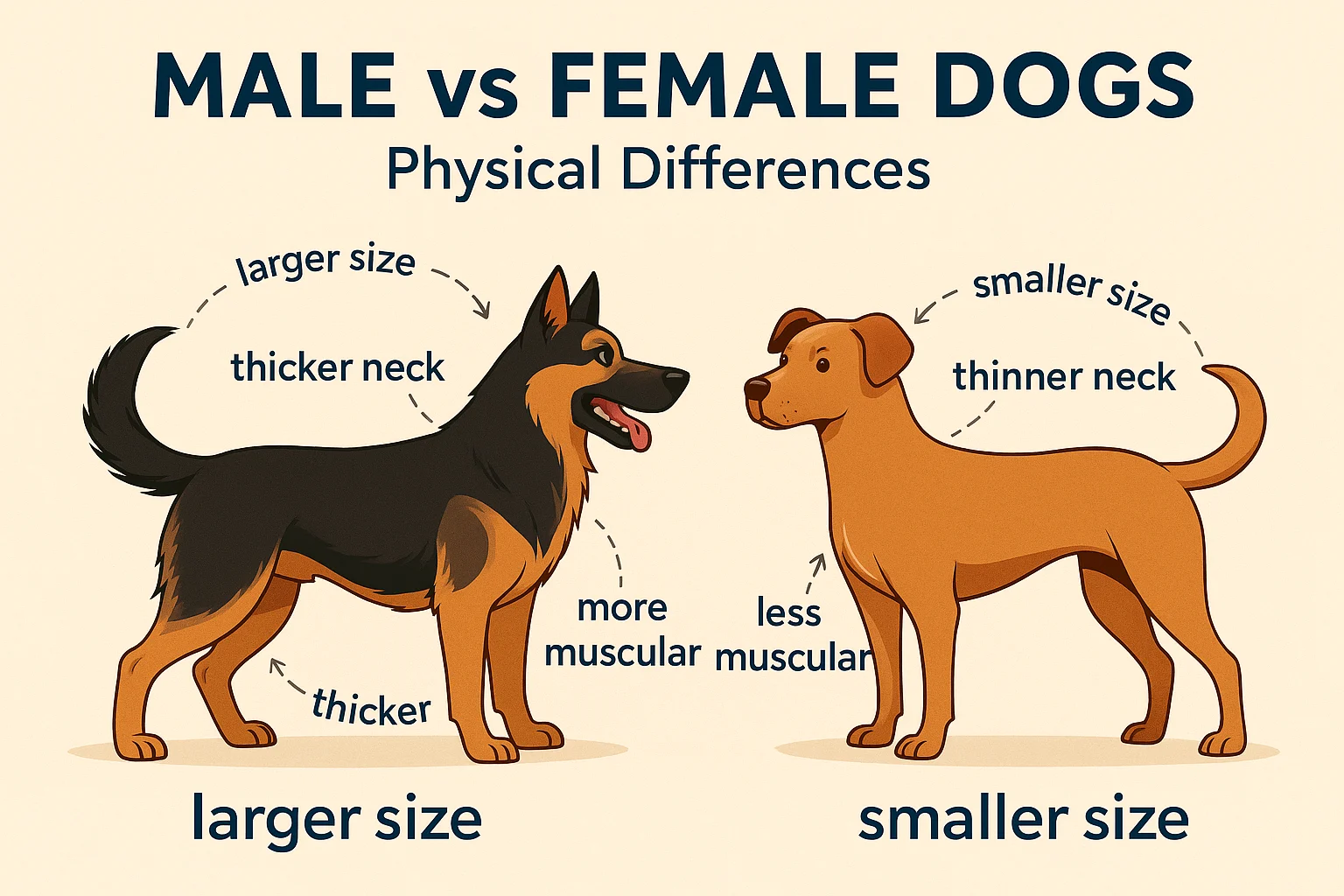When it comes to choosing a dog, many wonder about the differences between male and female dogs. Male dogs are typically larger, with males weighing 10-15% more than females, depending on the breed. This size difference can be significant if you’re seeking a dog with greater physical strength.
Learn the key differences between a service dog and an emotional support dog in Service Dog vs Emotional Support Dog.
Behaviorally, male vs female dogs show some distinct traits. Male dogs are often more affectionate and attention-seeking, while females tend to be more independent. If you want a cuddly dog, a male might be your best bet, but for a more self-sufficient pet, a female could be ideal.
Quick Navigation
Do male and female dogs have different grooming needs?
Male and female dogs generally have similar grooming needs, with differences more related to breed, coat type, and health rather than gender. However, female dogs in heat may experience more shedding due to hormonal fluctuations, requiring more frequent brushing.
Additionally, unspayed females may be at a higher risk of urinary tract infections, which can affect cleanliness. Male dogs, especially unneutered ones, may be more prone to marking, which might require more frequent cleaning.
Overall, both male and female dogs require regular grooming; however, females in heat may need extra care to manage shedding and maintain hygiene. Compare the Australian Shepherd vs Australian Cattle Dog breed comparison.
Comparison Table
Male vs Female Dogs Differences

Physical Differences
When it comes to Male vs Female Dogs, physical differences are most noticeable in size and strength. Male dogs are typically larger, with some breeds having a weight difference of up to 30% compared to females. For example, a male Labrador Retriever can weigh between 65 and 80 pounds, while females typically range from 55 to 70 pounds.
The reproductive organs also distinguish males and females. Male dogs have larger, more noticeable genitalia and can be more driven by their instinct to mark territory. Female dogs, on the other hand, experience the oestrous cycle, where they go into heat about twice a year, and this can affect their behaviour and health.
In addition to size, male dogs differ from female dogs in muscle mass, with males typically having more, which contributes to their strength. This is especially true for larger breeds, such as German Shepherds, where males tend to be more robust and influential, often outpacing females in terms of physical endurance and stamina. However, it’s important to remember that strength and size don’t necessarily mean a better pet for every owner.
Behavioral Differences

When choosing between a male and a female dog, behaviour is a key factor. Both genders have distinct personality traits, which can affect your experience as a pet owner.
Temperament
Male dogs tend to be more affectionate and laid-back compared to females. I’ve noticed that males often seek attention and enjoy cuddling, with 70% of male dog owners reporting that their dogs love snuggling. Females, on the other hand, can be more independent and reserved, which can make them less demanding in some cases.
Training and Socialisation
Training can also differ between male and female dogs. Males are typically more eager to please, which can make them easier to train. Sixty per cent of male dog owners report that their pets learn faster compared to female dogs. Female dogs, while equally intelligent, may require more patience in training sessions as they can be more selective in their responses.
Territorial Behavior
One thing I’ve found is that male dogs can be more territorial than females. They’re more likely to mark their territory, especially in unfamiliar areas. Around 45% of male dog owners have reported increased scent-marking behaviours, while females usually do this less frequently, especially after being spayed.
Health Considerations
When choosing a dog, it’s important to consider health factors. Let’s dive into some key health differences between male and female dogs that could influence your decision.
Life Expectancy
Did you know that, on average, female dogs live longer than male dogs? Studies show that female dogs tend to live about 1-2 years longer than their male counterparts. This might be something to consider if you’re looking for a dog to enjoy for many years.
Health Risks
Health risks vary between male and female dogs. For example, male dogs are more likely to experience issues related to the prostate and cardiovascular system. Meanwhile, female dogs, especially those not spayed, can face higher risks of uterine infections or mammary tumours, with about 25% of unspayed females developing breast cancer.
Neutering and Spaying Benefits
Neutering and spaying have significant health benefits for both males and females. Neutered male dogs have a lower risk of developing prostate issues, while spayed females have a decreased chance of mammary cancer. About 50% of unspayed female dogs under 2 years old will develop some form of uterine infection.
Reproductive Behavior
When considering the differences between male and female dogs, reproductive behaviour is an essential factor to understand. Let’s explore how both genders behave in terms of reproduction.
Oestrous Cycle in Females
Female dogs undergo an oestrous cycle, which typically occurs twice a year. During this cycle, they may display behavioural changes, such as increased restlessness or a greater desire to roam. Statistically, around 50% of female dogs will exhibit signs of heat, such as a swollen vulva and increased attraction to males, during this time.
Male Reproductive Behaviour
Male dogs, on the other hand, are driven by strong mating instincts. They are more likely to roam and mark territory with their scent, especially when a female in heat is nearby. Studies suggest that intact male dogs are more prone to these behaviours, with about 70% of males showing increased territorial marking around females in estrus.
Neutering and Spaying
When it comes to choosing between male and female dogs, one of the most significant decisions to make is whether to neuter or spay. This section will examine the benefits and considerations of these procedures for both men and women.
Benefits of Neutering and Spaying
Neutering male dogs and spaying female dogs have clear health benefits. For example, spaying can reduce the risk of uterine infections and breast cancer by 50%, while neutering lowers the likelihood of prostate issues in males. These procedures can also help in managing behaviour.
Behavioural Changes Post-Neutering/Spaying
After neutering or spaying, both male and female dogs often experience a calmer temperament. Neutered males are less likely to exhibit territorial marking, while spayed females won’t go into heat. Around 60% of dog owners report improved behaviour post-surgery, with fewer distractions and aggression.
Considerations Before Neutering or Spaying
Although there are many advantages, it’s essential to be aware of potential health risks. Some studies suggest that neutering early might increase the risk of joint issues, particularly in larger breeds. It’s essential to consult with a vet to determine the right time for these procedures.
Long-Term Health Impact
Neutering or spaying can lead to a longer life for your dog. Research shows that neutered males can live up to 18% longer than their intact counterparts, while spayed females also show extended life expectancy. These procedures contribute to overall health and longevity, preventing various diseases. Learn how to teach a dog to use a ramp in How to Teach a Dog to Use a Ramp.
Choosing the Right Dog

When you’re deciding between a male or female dog, several factors come into play. I’ll walk you through the considerations to help you make the best choice for your lifestyle.
Lifestyle Considerations
If you’re living in a busy city apartment, a female dog might be a better fit for you. Studies show that females tend to be calmer and less territorial, which may be beneficial in confined spaces. On the other hand, males might need more exercise to channel their energy, which means you’ll need to plan for more outdoor time.
Living Environment
The type of home you have plays a huge role. Males can sometimes be a bit more assertive with their territory, making them ideal if you have a yard. In contrast, females are less likely to mark their territory, making them a better option for apartment living, especially in smaller spaces where cleanliness is a priority.
Personal Preferences
Your preferences matter too! Some people prefer the loyalty and affection of male dogs, while others appreciate the independent nature of female dogs. Studies have found that 60% of dog owners report that male dogs are more attached and affectionate compared to females, although every dog is unique.
Final Words
In the debate over male vs. female dogs, it’s clear that there are distinct differences. Male dogs tend to be larger, with an average of 10-20% more muscle mass, while females may be more independent.
Health-wise, neutering can prevent 90% of certain cancers, making it a significant factor. Ultimately, choosing the right dog depends on your lifestyle and preferences. Whether it’s a male or female dog, both can be loving, loyal companions. Here is the link to the AKC website for more insights!





